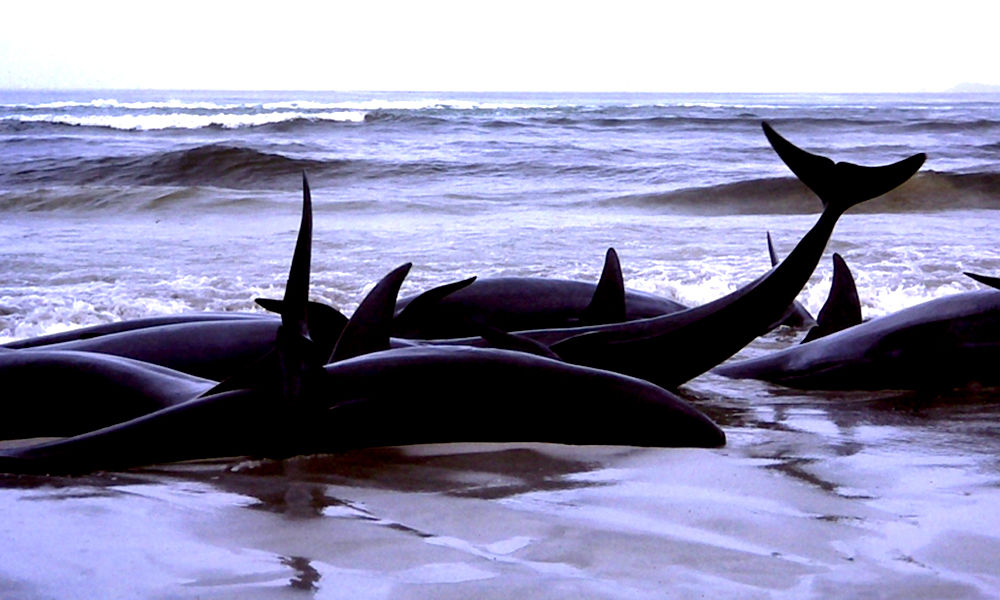In what is believed to be Australia’s worst stranding on record, around 380 whales have died after getting beached on Tasmania’s west coast.
Of the 470 stranded animals, rescuers were able to release 88 into the ocean, with around 20 remaining to be well enough to be rescued.
According to a report by The Guardian, Nic Deka, the coordinator of the rescue from Tasmania Parks and Wildlife Service, on Thursday, September 24, said that their focus was now on gathering the hundreds of dead whales lying across sandbanks, bays and floating in the water.
‘We think there are around 20 still viable to release from the sandbar [at Fraser Flats]. It is a complex site and many whales are submerged. It’s difficult to assess which are alive and dead. But we have about 20 that we think have the strength to be released,’ Deka was quoted as saying by the media.
According to Dr Kris Carlyon, a marine conservation program wildlife biologist, the rescuers had tried to release the animals to be euthanised.
‘These are animals that we have given them a chance and tried release and they haven’t done well and that’s purely down to the situation they’ve found themselves in,’ Carlyon said.
A spokesperson for Tasmania’s Department of Primary Industries, Parks, Water and Environment said that Euthanasia will be by a firearm with customised ammunition. The spokesperson added the method ‘is in line with world best practice for euthanising a whale species of this size.’
Meanwhile, the Tasmanian government officials said the rescue effort would continue ‘as long as there are live animals.’
‘While they’re still alive and in water, there’s still hope for them – but as time goes on they do become more fatigued,’ Deka was quoted as saying by BBC.
A rescue team of around 60 people are using slings and other equipments to help pull the surviving whales off the sandbanks so that they can be fully immersed in the water. Once the whales are ‘re-floated’, they will be guided back into deeper waters.
Tom Mountney, a fisherman helping with the rescue operation, told BBC World Service radio, ‘Geographically it’s quite a challenging area. It’s sort of inside an actual harbour so we’ve got several boats and hundreds of people on the ground preparing the whales in slings.’
‘They are remarkably calm. Some of them obviously, being a several ton animal, are quite strong so there’s inherent danger in dealing with them. But it’s as if there’s a bit of a sense of them knowing what we’re trying to do,’ Mountney added.
Meanwhile, efforts are also on to collect the carcasses. Usually, during stranding, while experts prefer to leave the bodies, Carlyon said that it was not viable in this case as the area is too close to human campgrounds and activity sites.
The rescuers have already started gathering the dead whales, amid concerns that the whales would ‘bloat and float’ and then begin to drift, leading to a navigation hazard in the harbour, Deka said.
‘They could also attract predators such as sharks and that’s always a risk. The decomposition could also affect oxygen levels in parts of the harbour,’ Deka added.
He added that they were trying to tow the animals out into the ocean and that efforts were underway on Thursday afternoon to stop the dead mammals from floating away. The long-finned pilot whales can grow up to seven metres long and weigh up to three tonnes.
In order to help with the disposal of the dead bodies, a 32-metre barge with a crane attached will arrive from the state-owned TasPorts corporation on Monday. The MV Kulanda can carry a 92-tonne load. Furthermore, boats from the harbour’s fish farming industry will also be used for the operation, Deka said.
The rescue unit constitutes around 40 government staff, 20 volunteers mainly from the harbour’s fish farming industry, and around 17 surf lifesavers.
‘My focus is on doing the best job we can. Now it’s looking ahead to collect and dispose of the carcasses,’ Daka said.
Meanwhile, Carlyon said that they would probably never know for sure what brought the pilot whales into the shallow water and into the harbour.
‘The most likely scenario is that something has brought them close to the coast – and most likely that’s food – and then they’ve got themselves into trouble,’ Carlyon said.
One Of Worst Mass Strandings In History
The current stranding is one of the largest recorded across the world and the biggest in Australia. The last mass stranding was recorded in Tasmania in 2009 when 200 whales got stranded in the beach. Meanwhile, the largest stranding previously recorded in the country was in Western Australia in 1996 when 320 pilot whales got stuck and only 20 survived.
In 2018, over 200 pilot whales died in a week’s time in New Zealand, in separate strandings off the country’s east coast. In pictures of the incident that surfaced online, dozens of whales were seen stranded on an idyllic beach in a remote part of the country.
The largest known whale stranding occurred in 1918 when around 1,000 pilot whales got stranded in New Zeal…











